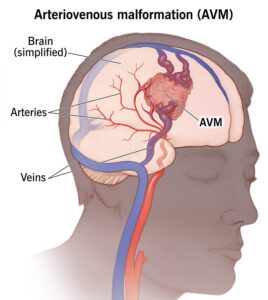What is Arteriovenous malformations (AVMs)?
Arteriovenous malformations (AVMs) are rare vascular anomalies characterized by an abnormal connection between arteries and veins, bypassing the capillary system. This direct connection disrupts the normal blood flow and oxygen circulation, potentially leading to various health complications. AVMs can occur anywhere in the body but are most commonly found in the brain and spinal cord.

Understanding Arteriovenous Malformations
In a typical circulatory system, arteries transport oxygen-rich blood from the heart to various tissues. Within these tissues, blood passes through a network of tiny vessels called capillaries, where the exchange of oxygen, nutrients, and waste products occurs. The deoxygenated blood is then carried back to the heart through veins. In the case of an AVM, this process is disrupted due to a tangled web of arteries and veins that connect directly, bypassing the capillaries. This can lead to several issues:
Increased Pressure on Veins: Veins are not designed to handle the high pressure of arterial blood flow. The direct connection can cause veins to become engorged or even rupture, leading to bleeding.
Reduced Oxygen Delivery: Bypassing the capillary network means that the surrounding tissues may not receive adequate oxygen and nutrients, potentially causing tissue damage or death.

Causes and Risk Factors of Arteriovenous malformations (AVMs).
The exact cause of AVMs is not well understood. They are generally believed to develop during fetal development, suggesting a congenital origin. However, most AVMs are not inherited and occur sporadically. Some genetic conditions, such as hereditary hemorrhagic telangiectasia, have been associated with an increased risk of developing AVMs.

Symptoms of Arteriovenous malformations (AVMs)
- The symptoms of an AVM depend largely on its location and size. Many individuals with AVMs remain asymptomatic and may never experience any related health issues. However, when symptoms do occur, they can vary:
- Neurological Symptoms: If the AVM is located in the brain or spinal cord, symptoms may include headaches, seizures, weakness or numbness in limbs, vision changes, difficulty speaking, or unsteadiness.
- Bleeding: The most serious complication of an AVM is hemorrhage. In the brain, this can lead to a hemorrhagic stroke, characterized by a sudden, severe headache, nausea, vomiting, loss of consciousness, or neurological deficits.
- Other Symptoms: AVMs in other parts of the body may present as a noticeable pulsating mass, pain, or swelling.
Diagnosis of Arteriovenous malformations (AVMs)
- Diagnosing an AVM typically involves a combination of imaging studies and clinical evaluations:
- Magnetic Resonance Imaging (MRI): Provides detailed images of soft tissues and is particularly useful for identifying AVMs in the brain and spinal cord.
- Computed Tomography (CT) Scan: Often used in emergency settings to quickly assess for bleeding in the brain.
- Cerebral Angiography: Considered the gold standard for diagnosing brain AVMs, this procedure involves injecting a contrast dye into the blood vessels and taking X-ray images to map the vascular structure.
- Ultrasound: Useful for detecting AVMs in other parts of the body, especially in prenatal cases or superficial lesions.
Treatment Options of Arteriovenous malformations (AVMs)
- The management of AVMs depends on various factors, including their size, location, the presence of symptoms, and the overall health of the patient. Treatment strategies may include:
- Observation: In cases where the AVM is small, asymptomatic, and located in a non-critical area, careful monitoring with regular imaging studies may be recommended.
- Medications: While there are no medications to cure an AVM, drugs may be prescribed to manage symptoms such as headaches or seizures
- Surgical Resection: This involves the complete removal of the AVM and is often considered when the AVM is accessible and the risk of surgery is deemed lower than the risk of rupture.
- Endovascular Embolization: A minimally invasive procedure where a catheter is used to deliver materials that block the abnormal vessels, reducing blood flow to the AVM. This is sometimes performed as a prelude to surgery or radiosurgery.
- Radiosurgery: A non-invasive treatment that uses focused radiation beams to cause the AVM vessels to thicken and close off over time. This method is typically used for smaller AVMs or those located in areas that are difficult to access surgically.
Potential Complications of Arteriovenous malformations (AVMs)
The primary risk associated with an AVM is bleeding. The annual risk of hemorrhage from a brain AVM is estimated to be around 2-4%. Factors that may increase the risk of bleeding include a history of previous hemorrhage, deep brain location, and certain vascular characteristics. Other potential complications include:
- Neurological Deficits: Depending on the location of the AVM, individuals may experience permanent neurological impairments.
- Hydrocephalus: Bleeding from an AVM can block the flow of cerebrospinal fluid, leading to an accumulation of fluid in the brain.
- Heart Failure: Large AVMs can create significant shunts between arteries and veins, leading to high-output heart failure, especially in infants.
A diagnosis of an AVM can be daunting, but many individuals live normal lives with proper management. Regular follow-ups with a healthcare provider are essential to monitor the AVM and address any emerging symptoms promptly. Patients are often advised to avoid blood thinners and activities that increase blood pressure, as these can elevate the risk of bleeding
What are arteriovenous malformations (AVMs) of the brain?
AVMs are abnormal tangles of blood vessels connecting arteries and veins in the brain. They disrupt normal blood flow and oxygen circulation, which can lead to headaches, seizures, or even bleeding in the brain.
Where can arteriovenous malformations be found in the body?
AVMs can occur anywhere in the body but are most commonly found in the brain and spinal cord. When present in the brain, they pose a higher risk due to potential bleeding and neurological complications.
What causes arteriovenous malformations, and are they hereditary?
The exact cause of AVMs is not fully understood, but they are typically congenital, meaning present at birth. Most AVMs are not inherited, although very rare genetic conditions can increase the risk of vascular malformations.
What is the best treatment for arteriovenous malformations (AVMs)?
Treatment options depend on the size, location, and risk of rupture. They may include surgical removal, endovascular embolization, or stereotactic radiosurgery. A neurospecialist evaluates the best approach based on individual patient factors.




